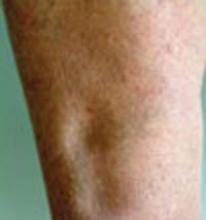The differential diagnosis, in descending order, includes: elevated pulmonary artery pressure (often due to obstructive sleep apnea), congestive heart failure, idiopathic causes, venous insufficiency, use of nonsteroidal anti-inflammatory drugs (NSAIDs), and proteinuria (>1 g daily) (strength of recommendation: B, based on a nonconsecutive diagnostic cohort study with good reference standards).
Test for DVT in those with unilateral leg edema
Marcia Lu, MD
Department of Family and Community Medicine, University of Nevada School of Medicine, Reno
Based on presented evidence, it is premature to make the initial diagnosis of venous insufficiency without further evaluation through cardiovascular testing in patients >45 years of age.
Though this Clinical Inquiry is very convincing, I recommend cautious interpretation of this data due to the relatively small sample size, type of study, and demographics of the study population. A final note: remember to exclude pregnancy in women of reproductive age, and consider tests to exclude deep venous thrombosis in patients presenting with unilateral leg edema.
Evidence summary
Chronic leg edema is defined as palpable swelling caused by an increase in interstitial fluid volume lasting at least 72 hours.1
We were able to find only 1 moderate-quality study regarding the diagnosis of bilateral lower extremity edema that included a thorough cardiovascular evaluation.
Single study in bilateral leg edema: What the FPs thought…
A nonconsecutive cohort study2 evaluated the causes of bilateral leg edema among 58 ambulatory adults (between 29 and 83 years of age) enrolled from an inner-city family medicine clinic in Cleveland. Edema was present for >3 months in 78% of patients, and 84% were obese. Patients were excluded if the edema was known to be due to nifedipine, intra-abdominal malignancy, hypothyroidism, or idiopathic cyclic edema.
Family physicians obtained a history and performed a physical exam on all patients and recorded a clinical diagnosis for the edema. Initial clinical impressions included: venous insufficiency (71%), congestive heart failure (18%), nephrotic syndrome (13%), uncertain (7%), and other causes (2% each). Other causes included lymphedema, pulmonary hypertension, cor pulmonale, hypoalbuminemia, NSAID or corticosteroid use, sleep apnea, and obesity. (Total percentages exceed 100% because some patients had multiple conditions.)
All patients were then evaluated with a serum albumin, a 24-hour urine protein collection, echocardiogram, and lower extremity duplex venous ultrasound (13 of 58 patients did not complete the echocardiogram and venous duplex ultrasound). Investigators developed a final diagnosis using the results of this evaluation in conjunction with the clinical information obtained by the physician.
…and what the testing revealed
Final diagnoses included pulmonary hypertension/borderline pulmonary hyper-tension (>30 mm Hg) (42%), congestive heart failure (29%), idiopathic edema (27%), venous insufficiency (22%), medication use (15%, primarily corticosteroids and NSAIDs), proteinuria >1 g/day (15%), and other causes (2% each). These other causes included transient renal disease, hypoalbuminemia, lymphedema, and stenosis of the inferior vena cava. (Total percentages again exceed 100% because some patients had multiple diagnoses.)
All 15 patients with cardiac conditions and 17 of 19 patients with pulmonary hypertension were over 45 years of age. Of the 19 patients with pulmonary hypertension, 6 had CHF, 4 had chronic obstructive pulmonary disease, 4 had sleep apnea diagnosed in subsequent testing, 1 had an atrial septal defect, and 4 appeared to have primary pulmonary hypertension.
Investigators recommend 3 steps
The investigators recommended 3 steps to evaluate chronic leg edema.
- Stop any potentially causative medicines, such as NSAIDs or calcium-channel blockers.
- Obtain an echocardiogram if the patient is 45 years of age or older.
- Obtain a sleep study if the echo-cardiogram reveals pulmonary hypertension without an apparent cause.
Recommendations from others
The authors of a recent narrative systematic review1 stated that “most patients with chronic leg edema can be assumed to have venous insufficiency, CHF, or cyclic edema, unless another cause is suspected after a history and physical examination.” They also stated that: “pulmonary hypertension and early CHF can both cause leg edema before they become clinically obvious” and reiterate that patients over 45 years of age with edema of unclear cause should have an echocardiogram to rule out pulmonary hypertension.


